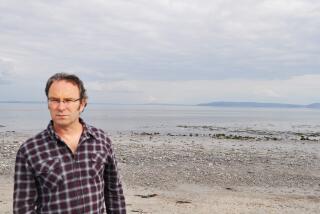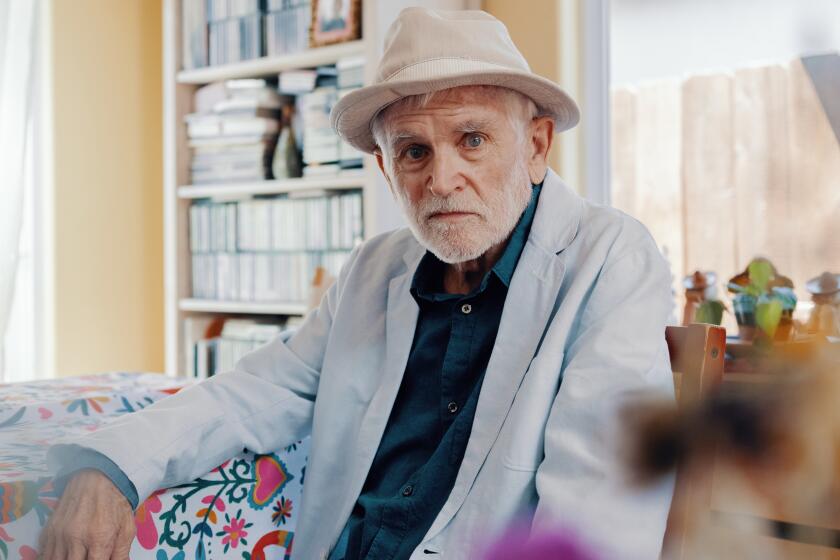All A-Bloom 100 Years to the Day
- Share via
DUBLIN, Ireland — On June 16, 1904, Nora Barnacle accepted an invitation from aspiring author James Joyce, and their perambulation changed the course of modern fiction. On Wednesday, the centenary of that fateful walk, lovers of writing from around the world made a pilgrimage to the low haunts and high places immortalized in Joyce’s opus “Ulysses” to celebrate the humanity and the extraordinary genius contained in his portrait of early 20th century Dublin.
Everywhere one looked, there were men in jaunty bowlers and straw hats and women in lacy, flouncy, bosom-revealing frocks, doing their best to reenact the feeling of Dublin on the day of Joyce’s first meeting with the woman who became his wife, a date he immortalized by using it in his complex, symbol-laden “Ulysses” -- which pioneered stream-of-consciousness narrative and accurate depictions of thoughts, passions and bodily functions.
Bloomsday, named for the novel’s hero, has become an annual festival in Dublin and cities around the world, but this year’s festival -- “ReJoyce Dublin 2004” -- was the largest ever. It blended scholarship with humor, food and drink, music and poetry.
Outside the James Joyce Cultural Center, fans breakfasted on grilled kidney while actors representing the novel’s chief characters wandered about: cuckolded advertising salesman Leopold Bloom; his wife, Molly; and the young lapsed Catholic and bard-in-the-making Stephen Dedalus.
Lovers of Joyce had their own wanderings too, visiting the Martello Tower in Sandy Cove, where Dedalus lived with the loquacious Irishman Buck Mulligan and the restrained Englishman Haines. Then to Davy Byrne’s pub, whence they spilled out into Duke Street, imbibing Burgundy wine and sandwiches of brown bread and Gorgonzola cheese, for 10 Euros, or about $13, a pop.
And in the evening, it was on to the Spire, a soaring steel needle in O’Connell (formerly Sackville) Street, for a reenactment of “The Parable of the Plums,” a passage in “Ulysses” describing how two elderly women climbed the no-longer-extant statue of Nelson and showered plum pits on the people of the city.
Censored, self-exiled and usually short of money, Joyce would be astounded to know that 82 years after his novel’s publication, not only is he lionized by the Ireland that rejected him, but his pinched visage has become a cult image for the rest of the world -- or at least for intellectuals who have struggled with, and sometimes even finished reading, “Ulysses” and the even more impenetrable “Finnegans Wake.”
The festival attendees at the breakfast Wednesday on Great George’s Street included a group of Cambridge University retirees, English scholars from Taiwan and members of a book club from the Norwegian city of Trondheim who had met once each month to read “Ulysses” aloud from start to finish, taking three years.
The Scandinavians’ affection for Joyce stemmed in part from the writer’s homage to Henrik Ibsen: Joyce actually learned Norwegian so that he could correspond with the playwright in his own tongue, said Arne Strand, a school administrator in Trondheim.
Strand’s colleagues offered a reporter a nibble of the Gorgonzola at Davy Byrne’s and said they were attracted to the character of the marginalized Bloom, a Jew betrayed by his wife and seemingly unaware of the snide treatment he receives, yet who endures and finds power in his life.
Kenneth O. Turner, a retired member of the education faculty at Cambridge, tried to explain the novel’s special place.
“ ‘Ulysses’ is almost the first major work entirely focused on ordinary people, treating them very humanely but honestly. You can get a real insight into the thoughts and dreams of Dubliners of that particular period. And while there are no holds barred, there also is no rancor,” he said.
Laura Weldon, the American coordinator of the festival, which runs from April through August, had to fend off some critics who feared a dumbing-down of the Joycean canon. The actors, festivals, entertainment and food might be scoffed at by some, but they raise the curiosity of people who might not otherwise want to take up the challenge, she said.
“Ultimately, you want to get people to go to the text, and ‘Ulysses,’ let’s be honest, is not a beach read,” she said. “And the feedback so far is, yes, we’ve done it. People are saying they want to learn more about Joyce. They want to know more.”
The festival included symposiums on Joyce at the National College of Ireland -- 800 scholars from around the world delivering about 600 papers -- and an interactive exhibition of manuscript notebooks by the great man at the National Library, which also itself figures in the novel.
Weldon said she did not know how many people had traveled to Ireland for the festival, but noted that the breakfast Wednesday had drawn 1,300 people and that more than 2,000 had attended a breakfast and street fair Sunday.
It was important to appeal to a broad range of interests, she said, and “I think we’ve managed to do an awfully good job” of offering something for everyone.
That seemed to be the verdict of the participants as well.
Spike and Carol Barkin -- he a festival producer at Lincoln Center in New York, and she a writer -- had been planning their trip for three years.
They have been lovers of “Ulysses” since college, and June 16 happens to be Spike Barkin’s birthday.
Looking out over the bay at Sandy Cove, below the tower that is the scene for the book’s opening episode, Barkin said the book had so many riches that could be plumbed again and again for new meanings and insights in every reading.
“It’s probably a book you could spend an entire lifetime studying -- and that wouldn’t be bad,” he said.
More to Read
Sign up for our Book Club newsletter
Get the latest news, events and more from the Los Angeles Times Book Club, and help us get L.A. reading and talking.
You may occasionally receive promotional content from the Los Angeles Times.








